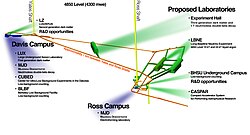LZ experiment
LUX-Zeplin (LZ) experiment | |
|---|---|
experiment | |
 | |
| Country | |
| State | |
| Website | The LZ Dark Matter Experiment |
The LUX-Zeplin (LZ) experiment is a WIMP detector.[1] The international collaboration constructing it formed in 2012 by combining the LUX and ZEPLIN groups. It is to be located at the Sanford Underground Research Facility (SURF) in South Dakota,[2] and managed by DOE’s Lawrence Berkeley National Lab (Berkeley Lab). The LZ experiment is a next-generation dark matter direct detection experiment. When completed, the experiment will be the world’s most sensitive experiment for WIMPs (Weakly Interacting Massive Particles) over a large range of WIMP masses[3] In the spring of 2015, LZ passed the ‘Critical Decision Step 1’ or CD-1 review, and became an official DOE project.[4] As of May 2021, the detector is being commissioned.
LZ is a collaboration of 30 institutes in the US, UK, Portugal and Russia. Henrique Araújo from the Imperial College of London leads the UK team on LZ.[5]
References[]
- ^ Toomey, Emily (3 February 2020). "New Generation of Dark Matter Experiments Gear Up to Search for Elusive Particle". Smithsonian Magazine. Retrieved 11 April 2021.
- ^ LZ Lab Technician (Materials Laboratory Technician) HigherJobEd of "South Dakota School of Mines and Technology"
- ^ Next-Generation Dark Matter Experiments Get the Green Light by Kate Greene in a press release of "Lawrence Berkeley National Laboratory" on July 15, 2014
- ^ Welcome to the LZ dark matter experiment’s webpage
- ^ New dark matter detector gets green light by Gail Wilson of "Imperial's News site" on 18 August 2014
External links[]
- Science and technology in the United States
- Experiments for dark matter search
- Underground laboratories
